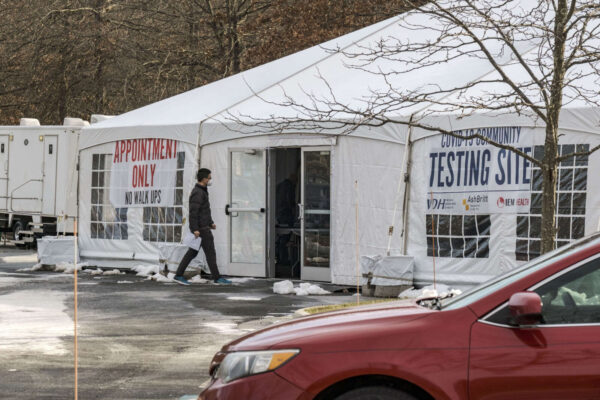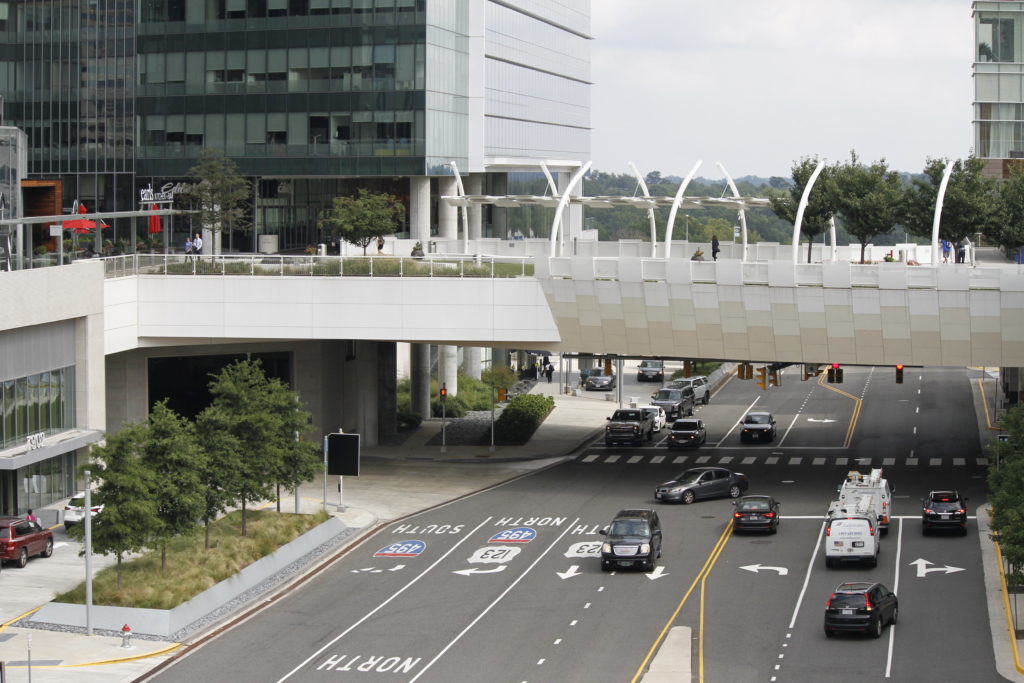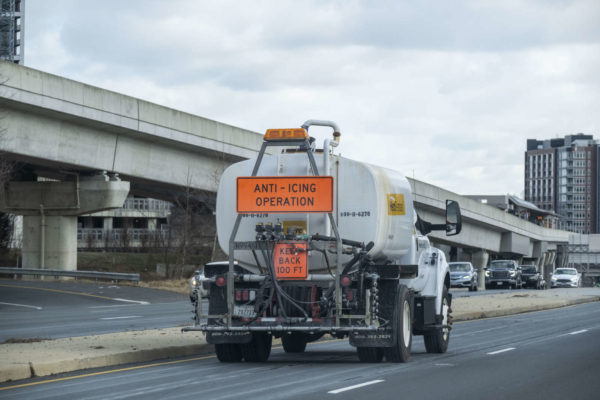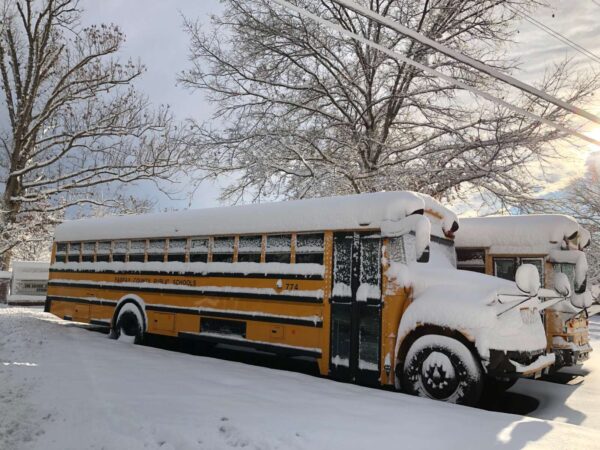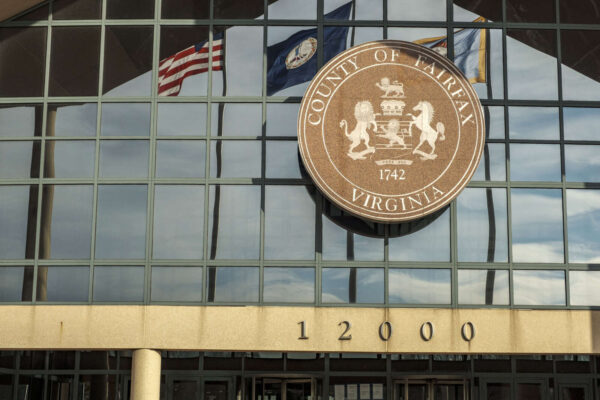
Fairfax County is working on ways to ensure that consistent and fair wages are linked to public construction contracts.
At a board meeting on Tuesday (Jan. 25), the Fairfax County Board of Supervisors voted unanimously to require all public construction contracts to abide by the prevailing wage — the hourly rate paid to most workers in specific niche coasts or in a labor market area.
The county was able to pass the measure after the Virginia General Assembly adopted enabling legislation in 2020 that went into effect in May of last year.
“Increasing protection of workers’ rights and ensuring that people are paid appropriately for their skills benefits not just those workers, but the community-at-large,” Board Chairman Jeff McKay told FFXnow. “Our county invests a lot of resources into our community to help struggling residents. Workers getting a fair wage helps families towards a path of self-sufficiency and into the middle class, which helps the entire community.”
Localities are allowed to adopt ordinances that require construction contracts to pay wages for their bidders, contractors, offers, and subcontractors at the prevailing wage rate.
The rate is determined by the Commonwealth’s Commissioner of Labor and Industry, which is guided by standards set by the U.S. Secretary of Labor.
County staff worked with stakeholders and professional cost estimators from the region in order to determine the impact of adopting the ordinance on construction costs. The workgroup helped the county formulate the ordinance that passed on Tuesday.
Such ordinances could have a disproportionate impact on small, women or minority-owned businesses. Other contractors and subcontractors may lack the administrative capacity to absorb the costs associated with the ordinance, a county memo noted.
However, the ordinance could level the playing field for all contractors by taking wages out of the equation, according to county staff. Minority businesses may be able to compete for county contracts, which may be underbid by low-road competition that is not from the area.
The county is working on ways to make sure that businesses have administrative support like software and resources in order to comply with the ordinance.
But it’s still unclear how adopting a prevailing wage affects construction project costs, according to county staff.
The Virginia Division of Engineering and Buildings, for example, accounts for a budget impact of 15% for construction costs. The cost impact can vary between 5 and 7.5% depending on the project type, according to the county.
Based on the county’s unique needs, the ordinance would increase costs by around 5%.
The ordinance goes into effect on July 1.
The state’s prevailing wage law — known as the Little Davis-Bacon Act — went into effect in May. The law requires contractors and subcontractors with contracts over $250,000 to pay the prevailing wage and benefits to all employees who are a part of that contract.
Contractors must verify the pay scale used for employees under the public contract. Itemization of the amount paid to workers is provided and payment records are verified.
If contractors fail to follow the law, the prevailing page must be paid, in addition to an annual interest rate of 8% that accrues when wages were first due.
The contractor is disqualified from bidding on all public contracts until workers are paid. Arlington County also has a prevailing wage ordinance.

Fairfax County is clearing the way for more residential development in land just east of Dulles International Airport.
A proposed airport noise policy would amend the Fairfax County Comprehensive Plan to permit new housing in approximately 2,300 acres of the Sully District, primarily around Chantilly, that are exposed to higher levels of airplane noise than currently allowed.
The county will launch the public engagement portion of its effort with two virtual open houses — one at 7 p.m. today (Thursday) and another at 11 a.m. on Saturday (Jan. 29).
Initiated by the Fairfax County Board of Supervisors on July 28, 2020, the goal of the amendment is to “enhance the county’s economic development opportunities” and add housing in a part of the county still dominated by older office and industrial buildings, according to a white paper on the proposal.
While the airport noise policy focuses on the Dulles area, putting it in the comprehensive plan would establish general standards for developers to account for aircraft-related noise levels, county staff told the board at a land use committee meeting on July 21, 2020.
“We think it’s important that the board look at this as a countywide policy, get it in the comprehensive plan so that it’s there, it’s available, people understand it,” Department of Planning and Zoning Director Barbara Byron said.
The alternative would be to make noise mitigation a condition for getting individual projects approved through the county’s zoning process, an approach that would be more unpredictable and challenging, according to Byron.
“We can’t stop some of the revitalization and activity from occurring in that area, nor should we,” Board of Supervisors Chairman Jeff McKay said. “We need economic development. We need housing. We know…how many units we are behind demand, which is a direct input into affordability.”
The comprehensive plan currently does not recommend residential development in areas with over 60 weighted decibels of day-night average sound levels (DNL), defined by the Federal Aviation Administration as a metric for a person’s cumulative exposure to sound over a 24-hour period.
The amendment proposes allowing residential uses in areas that experience 60 to 65 decibels. The only part of the county where that standard currently applies is around Dulles, based on airport noise contours developed by the Metropolitan Washington Airports Authority in 1993 and adopted by the county in 1997.
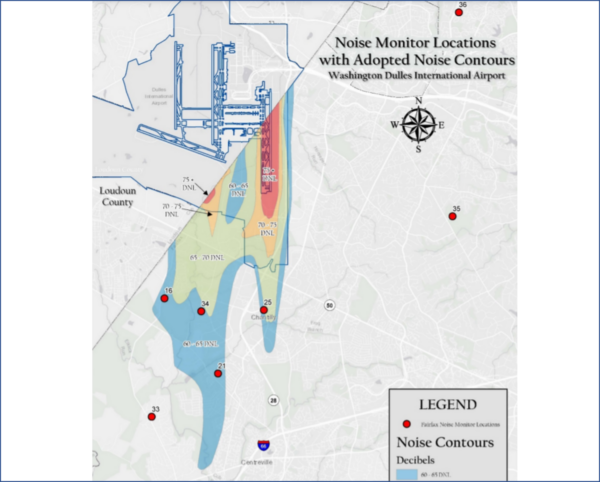
The county hasn’t adopted noise contours for the Davison Army Airfield on Fort Belvoir, and it’s not within MWAA’s 60 to 65-decibel contour for Washington National Airport.
As Sully District Supervisor Kathy Smith noted to FFXnow, the county already has some residential development within the 60-65 DNL contour.
Despite some vocal community opposition, the Board of Supervisors approved two new neighborhoods in November 2020 after amending the comprehensive plan a year earlier to permit residential development in Westfields, known as Land Unit J of the Dulles Suburban Center.
The approvals came with some noise mitigation requirements related to construction materials and notifying potential homeowners of the airport’s proximity, according to Smith.
The proposed airport noise policy will align the rest of the Dulles area with Land Unit J and create uniformity between the county’s comprehensive plan and its zoning ordinance, which was updated just last year, Smith says.
It would also bring the county in line with other jurisdictions across the country with international airports, including Loudoun County, which permits residential uses in the Dulles 60-65 DNL contours.
“This isn’t anything new or different,” Smith said. “The FAA says that residential is not compatible when you get over 65, but they don’t have any restrictions below that.”
While the county hopes to encourage more residential and mixed-use development in the Dulles area, Smith doesn’t anticipate a huge influx of new housing if the amendment is approved.
“With the exception of Land Unit J of the Dulles Suburban Center, most of the residential uses currently anticipated by the Plan within the Board adopted DNL 60-65 noise contours have been developed and are generally stable with limited opportunities for further residential development,” the county’s white paper says.
Photo via John McArthur/Unsplash

Updated at 11:50 a.m. — The Fairfax County Board of Supervisors voted 8-1 this morning to support the continued mask requirement in schools and approved a letter directing Virginia to work with local health and school officials on metrics for making masks optional.
Earlier: When students across Fairfax County returned to classrooms today (Tuesday), they came wearing the most contentious, must-have accessory of the school year: face masks.
While the devices have become the subject of fierce political debate, Fairfax County Public Schools officials say that tension has not carried over into school buildings, where they have encountered few issues with getting students and staff to wear masks.
Just 40 out of the division’s nearly 180,000 students have been cited for not wearing a mask since the requirement took effect on Aug. 20, FCPS Assistant Superintendent of Special Services Michelle Boyd said at a virtual town hall meeting last night (Monday).
“Certainly, students have had to be reminded to pull your face mask up and potentially to wear it appropriately, as we all have to have reminders,” Boyd said. “But by and large, we want to celebrate that FCPS students have stepped up and answered the call to keep themselves safe, to keep their friends safe, and to keep their community safe.”
Officials say the mask-wearing requirement, combined with vaccinations, testing, and other mitigation protocols, has proven effective so far at limiting the spread of COVID-19 in schools.
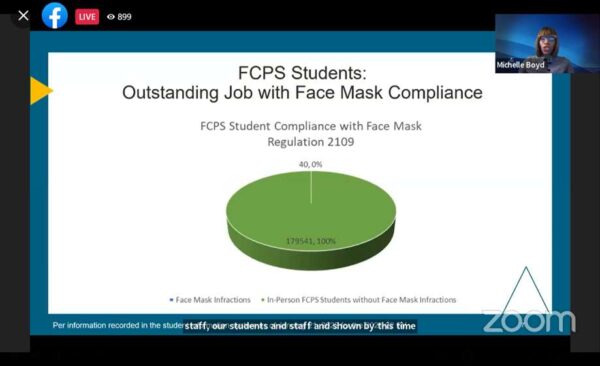
As of today, FCPS students, staff, and visitors have reported 6,362 Covid cases since August, including 2,681 cases this month — double the 1,317 cases seen in December.
Boyd noted that the number of cases still represents just a fraction of the district’s 206,111 students and staff, and while there have been 36 outbreaks reported, consisting of 155 cases, there have not been any since students returned from winter break on Jan. 10.
Unlike some other school systems in the area, FCPS has not reverted any schools to virtual learning due to Covid.
Still, with the school system seeing more cases than ever and community transmission levels high, albeit declining, Superintendent Scott Brabrand says FCPS needs to “stay the course” and maintain its current health and safety practices.
“We all seek a moment when we can go to creating mask-optional conditions, but now is not the time at the greatest surge we’ve ever had in the pandemic,” Brabrand said, stating later that FCPS is working with health officials to establish metrics for when to roll back masking and other requirements.
Whether FCPS will be allowed to continue with universal masking, however, is up to the courts after the county school board joined six other localities in filing a lawsuit yesterday to prevent Gov. Glenn Youngkin’s executive order directing schools to make masks optional from taking effect.
The complaint argues that the governor lacks the authority to issue and enforce the executive order, which it says violates the state Constitution and the state law adopted last year that requires schools to provide in-person instruction in accordance with Centers for Disease Control and Prevention mitigation strategies.
“We’re not here out of a desire, but rather, out of a need to ensure that we’ve got that separation of powers and we maintain our constitutional authority as locally elected school board members who answer and are ultimately accountable to our constituents,” Fairfax County School Board Chair Stella Pekarsky told FFXnow in an interview.
She declined to speculate on what would happen if the Arlington Circuit Court, where the lawsuit was filed, rules in favor of Youngkin but said the school board is confident it will prevail in the case.
Youngkin spokesperson Macaulay Porter said the governor’s office is “disappointed that these school boards are ignoring parents’ rights.”
“The governor and attorney general are in coordination and are committed to aggressively defending parents’ fundamental right to make decisions with regard to their child’s upbringing, education, and care, as the legal process plays out,” she said in a statement.
Virginia’s health and education departments released new guidelines on Friday (Jan. 21) to support Youngkin’s executive order, urging testing and vaccinations while suggesting mask-wearing should be a personal choice.
“There is presently a lack of consensus among health experts regarding the costs and benefits of mask-wearing for children in school,” the guidance says, stating that the N95 and KN95 masks recommended by the Centers for Disease Control and Prevention are “very tight and uncomfortable.”
However, local health officials disputed the assertion that there’s a lack of consensus on the benefits of masks in preventing COVID-19 transmission at last night’s town hall, noting that universal masking is still recommended by the CDC and the Fairfax County Health Department.
“The FCHD continues to highlight the benefits of masking and encourages masks as an important part of an overall layered prevention strategy,” the county health department said by email. “We are aware of the updated VDH guidance issued this weekend and are in the process of ensuring that our COVID 19 investigations and containment practices are aligned.”
Dr. Benjamin Schwartz, the county’s director of epidemiology and population health, and Dr. Russell Libby, a local pediatrician who founded the Virginia Pediatric Group, agreed that “the vast majority of evidence” suggests masks work and are most effective when worn by everyone.
“There are many variabilities relative to the materials, the fashion with which they are fitted, and the cooperation on a continuing basis in those settings,” Libby said. “…There’s a lot that’s evolving, but the best advice that can be given is that still masks are the way to go, that they help significantly reduce the likelihood of transmission.”
Community members shared a variety of perspectives on FCPS’ mask requirement, with some parents expressing frustration with the lack of choice and others thanking school officials for following federal and local health guidelines.
Brabrand described the mask mandate as part of a balancing act between individual rights and collective responsibility and sacrifice.
“I have the right to do things up until that right infringes on the rights of others,” he said. “The pandemic is really just a primary example of how my decision not to wear a mask or not to get vaccinated has a huge effect on others. I think that’s why it remains an issue that creates so much comment and commentary.”
Photo via FCPS
With a second week of consistently declining cases, Fairfax County’s current, omicron variant-fueled Covid wave has receded closer to the levels seen last winter.
The Fairfax Health District, including the cities of Fairfax and Falls Church, reported 607 new cases today (Monday). With 845 cases added yesterday (Sunday), it’s the first time since Dec. 20 and 21 that there have been fewer than 1,000 new cases on consecutive days.
The county is now averaging 1,150 cases per day for the past week — less than half the weekly average of 2,520 cases recorded on Jan. 13, when the pandemic’s latest surge appears to have peaked.
Last winter, the seven-day average peaked at 697 cases on Jan. 17, 2021.
The omicron surge’s decline can also be seen in the district’s testing positivity rate, which has dropped from 34.1% on Jan. 10 to 23.1%, as of last Thursday (Jan. 20). The seven-day average for hospitalizations has gone from 5.7 on Jan. 15 to 3.1 today, when four new hospitalizations were reported.
In total, the Fairfax Health District has recorded 164,209 COVID-19 cases, 4,400 hospitalizations, and 1,272 deaths, five of them in the past week.
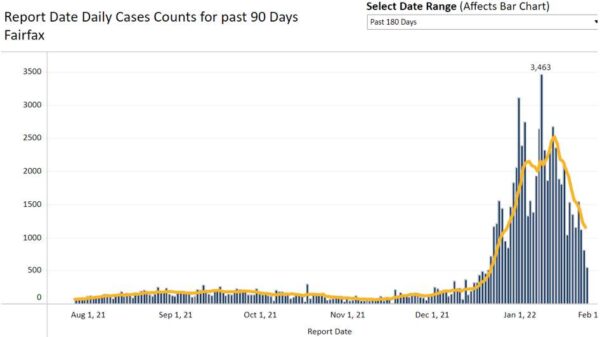
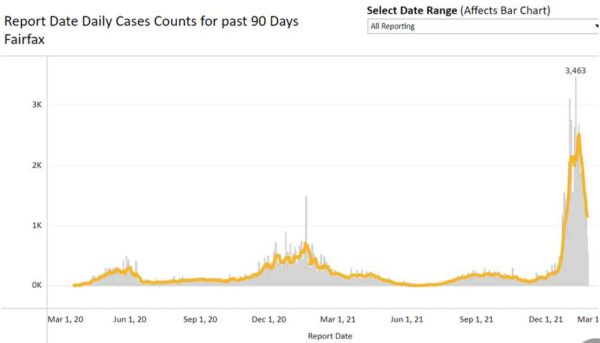
According to Fairfax County Health Department data, 840,040 residents overall — or 71% of the population — are fully vaccinated against Covid, including 80% of residents 18 and older.
The 949,105 residents, or 82% of the population, who have gotten at least one vaccine dose include:
- 89.7% of adults
- 94.9% of 16 to 17 year olds
- 90.4% of 12-15 year olds
- 47.6% of 5-11 year olds
In addition, 34.9% of Fairfax County residents, including 43.5% of adults, have gotten a booster shot or third dose, according to the Virginia Department of Health.
(Updated at 5:25 p.m.) Fairfax County Public Schools and six other school divisions, most of them in Northern Virginia, have sued to stop Gov. Glenn Youngkin’s order that makes face masks optional in schools.
As first reported by The Washington Post, the lawsuit was filed in Arlington Circuit Court this morning (Monday), asking the court for an injunction to stop Youngkin’s order from being enforced.
FCPS was joined by the school boards of Alexandria City, Arlington County, City of Richmond, Falls Church City, Hampton City, and Prince William County.
Collectively representing more than 350,000 students, the jurisdictions have all promised to continue requiring masks for students and staff, defying the executive order that Youngkin issued on Jan. 15, his first day in office, and was set to take effect today.
“The question for this Court is whether, by executive order, a governor can override both the Constitution of Virginia and a law enacted by the General Assembly,” the complaint says. “The School Boards respectfully submit that the answer to this question is no.”
In a joint statement, the suing school divisions say they’re seeking to defend “the right of school boards
to enact policy at the local level, including policies that protect the health and well-being of all students and staff”:
This legal action centers on fundamental questions about the framework of public education in Virginia, as set out in the Virginia Constitution and by the General Assembly. At issue is whether locally elected school boards have the exclusive authority and responsibility conferred upon them by Article VIII, § 7 of the Constitution of Virginia over supervision of the public schools in their respective communities, or whether an executive order can unilaterally override that constitutional authority.
Also at issue is whether a governor can, through executive order, without legislative action by the Virginia General Assembly, reverse a lawfully-adopted statute. In this case, Senate Bill 1303, adopted with the goal of returning students to safe in-person instruction five days a week in March 2021 and still legally in effect, provides that local school boards should follow The Centers for Disease Control and Prevention (CDC) health and safety requirements.
Without today’s action, school boards are placed in a legally untenable position — faced with an executive order that is in conflict with the constitution and state law. Today’s action is not politically motivated. These seven school divisions would welcome the opportunity to collaborate with the governor to ensure the safety and welfare of all students.
This lawsuit is not brought out of choice, but out of necessity.
With COVID-19 transmission rates high, our hospitals at crisis level, and the continued recommendation of health experts to retain universal mask-wearing for the time being, this is simply not the time to remove this critical component of layered health and safety mitigation strategies. School divisions need to continue to preserve their authority to protect and serve all our students, including our most vulnerable, who need these mitigation measures perhaps more than anyone to be able to continue to access in-person instruction.
FCPS Superintendent Scott Brabrand reaffirmed the division’s commitment to maintaining a mask requirement due to the spread of COVID-19 in a message to the community on Friday (Jan. 21), citing state law and a regulation that made masks part of the dress code, as of Aug. 20.
“We are working towards a day when we can begin to roll back these safety measures, including universal masking,” Brabrand said. “But for right now, we must continue to protect and serve all our students, including our most vulnerable. More than anything else, these mitigation measures allow them to safely remain in our schools.”

When Pedro Benedito Chimo Mandriz’s family returned to their home country of Angola, he stayed in the U.S. to pursue his dream of running his own restaurant.
Years later, the Lorton baker has taken a step to turning that dream into a reality after starting a pastry business in 2021 with the help of Escala, a rebooted counseling and business assistance program run by the nonprofit Northern Virginia Family Service.
Mandriz, 29, is one of 100 people who have benefited from Escala during the pandemic.
While working part-time at Manchester Bagel in Franconia, he took a class with Escala and launched Freaking Good Cakes, which specializes in German fruit cakes but also offers cupcakes and custom orders, all made out of his home.
“I was having the idea that to have or own a business in America, the only way is by doing…loans, and they showed me, no, that’s not the only way,” Mandriz said. “It helped open my eyes.”
Escala started in 2001 and stopped in 2017 before being rebooted during the pandemic. Its name comes from the Spanish verb escalar, meaning to climb, a nod to the program’s bilingual services.
The program’s small business counselor, Liga Brige, helps entrepreneurs develop their business ideas with marketing and financial assessments, frequently helping startups launch from owners’ homes.
“The majority of businesses established during those past years were usually in construction, in day care…in cleaning businesses and food,” Brige said.
During the pandemic, Escala’s participants have typically focused on the culinary arts, including female food service workers who realize they can prepare certain foods out of their homes, Brige says.
Known as food cottage laws, Virginia’s code lets private homes make some low-risk items without a food inspection, from baked goods to candies, dry seasonings, roasted coffee, and more.
“There are laws which allow you to produce from home certain foods, certain products which do not require a lot of licensing,” Brige said.
Most participants in Escala are Hispanic women, typically aged 36 to 55. Many were professional chefs in the hospitality industry and affected by the pandemic, while others were cooking out of their homes.
Escala’s successes so far include:
- Pizza Pita 24, a food truck that Colombian David Levy runs with his family
- Arepa Zone, Venezuelan cuisine with locations in D.C. and a commercial kitchen in Fairfax
- Dolce Amore Sweets, a Peruvian bakery and pastry shop in Manassas owned by Jennifer Solis
The program relies on government funding, and Northern Virginia Family Service plans to seek more grant money to expand Escala from Fairfax and Arlington counties for their upcoming fiscal years, which start in July.
Liga currently serves as the one-stop shop coordinator, but she hopes to have another counselor provide assistance to reach as many industries as possible.
Restricted to low-income adults in Virginia, D.C., and Maryland, the program offers counseling and workshops for free. A nine-week course costs $300.
Mandriz’s ultimate goal is to run his own restaurant that serves food from his country. His advice to new entrepreneurs? Take risks and listen to others’ expertise.
“Don’t be afraid,” he said. “Most of the people that want to go into business…they should be open to [listening] to other people’s information. They’re going to have a solid ground where they can build their business.”
Traffic safety advocates from across the D.C. area have banded together to urge local officials to make improvements that they believe could help prevent the next death of a pedestrian or cyclist.
The campaign specifically focuses on the Route 7 corridor around Baileys Crossroads and Seven Corners after 68-year-old Nguyet Ly was hit and killed when walking along a section of Leesburg Pike without a sidewalk on Dec. 13.
“The Route 7 corridor between these traffic hubs are among the most hazardous in Fairfax County,” said Phil Kemelor, Mason District board member for the community group Fairfax Families for Safe Streets.
Fairfax FSS has partnered with the Coalition for Smarter Growth, CASA, Fairfax Alliance for Better Bicycling, and other concerned individuals to ask the Virginia Department of Transportation to help.
In a letter to VDOT, the organizations recommend installing a continuous sidewalk or multi-use path on Leesburg Pike, adding crosswalks across all side streets, and prohibiting vehicles from parking within 20 feet of a driveway or intersection, which they say leads to blocked sightlines for drivers.
The letter also notes that the curbside lane where Ly was walking measures 16 feet in width, encouraging speeding compared to lanes that typically range from 10 to 13 feet.
“The Rt. 7 corridor in the Culmore community is a notoriously dangerous place for people walking, biking, and accessing the bus stops,” Sonya Breehey, Coalition for Smarter Growth’s Northern Virginia advocacy manager, wrote in an email. “The recent fatality is just one of many people who are struck and either killed or left with serious injuries in this community.”
While this campaign focuses on the Mason District, Fairfax FSS says the safety issues on Route 7, including insufficient sidewalks and crosswalks, can be seen elsewhere in the county as well and have contributed to other fatal crashes.
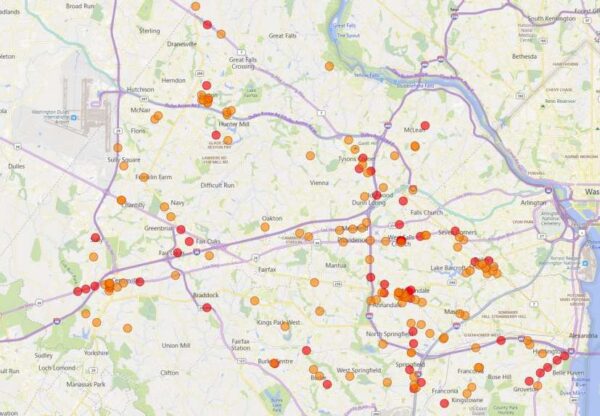
Based on five years of VDOT data, the group identified the following as the most dangerous roads in Fairfax County, in addition to Route 7:
- Route 1
- Route 29
- Route 50
- Little River Turnpike
- Backlick Road
- Telegraph Road
- Shreve Road at the Washington and Old Dominion Trail
- Eastbound sections of Columbia Turnpike
- Old Keene Road/Franconia Road
The data spanned September 2016 to September 2021 and involved over 100 crashes where pedestrians or cyclists were severely injured or killed.
“Nearly 50% of the fatalities are among those who are 60 years of age and older,” Kemelor said in an email.
Fairfax Families for Safe Streets has also compiled a map of “near misses” reported by pedestrians, cyclists, and drivers to show where streets could be upgraded. People can add to the map by completing an online survey.
Ly was the 13th pedestrian killed in a traffic crash last year in Fairfax County, which ended 2021 with 14 such deaths after an Annandale resident was hit by a car on Route 123 in Tysons and died on Dec. 30. The county also recorded three bicyclist deaths last year.
Police reported the first pedestrian fatality of 2022 on Tuesday (Jan. 18). The crash occurred on Jan. 8 on Route 29 at Forum Drive, and Joel Gonzalez, 22, of Fairfax later succumbed to his injuries while in a hospital.
White brine lines are a familiar sight on Fairfax County roads before snowstorms, such as the one that passed through the D.C. area last weekend.
Not too long ago, though, winter weather preparations involved scattering tons of dry salt and sand on streets, sidewalks, and other outdoor surfaces.
The adoption of brine to prevent snow and ice from sticking to pavement is part of a regional effort to limit the use of salt, which is effective — and cheap — as a de-icing material but pollutes the environment and corrodes infrastructure.
“What we’re trying to do is walk that fine line between protecting the natural resources, but at the same time, providing the need for public safety,” said Normand Goulet, a senior environmental planner for the Northern Virginia Regional Commission (NVRC).
The Salt Management Strategy
NVRC is overseeing the implementation of a Virginia Salt Management Strategy (SaMS) that the state Department of Environmental Quality released last year as a guide to minimizing the dangers of salt.
In the works since 2018, the strategy was developed by a committee that included Fairfax County staff after a water quality report identified de-icing salt as a primary contributor to excessive levels of chloride in Accotink Creek, affecting wildlife in the 51 square-mile watershed.
According to the Fairfax County Department of Public Works and Environmental Services (DPWES), one teaspoon of salt can permanently pollute five gallons of water.
The department advises residents to shovel snow early and often, apply salt only where needed, and sweep up extra material for reuse. Viable alternatives to salt include sand, wood ash, and native bird seed.
“One 12oz coffee mug holds enough salt to treat a 20-foot driveway or 10 sidewalk squares,” DPWES said by email.
Why Brine?
The SaMS toolkit encourages local and state government agencies to pay closer attention to the salt they use for anti-icing, which comes before snow to prevent accumulation, and de-icing, which removes snow and ice during or after a storm.
“It’s only been within these last few years where people have started to look at, okay, how can we cut down on the amount of salt we’re applying?” Goulet said.
The Virginia Department of Transportation began this winter with 250,000 gallons of brine, 120,000 tons of salt, and 25,000 of sand just for Northern Virginia.
The agency primarily uses dry sodium chloride, or rock salt, to remove snow, but it has increased its use of liquid brine for anti-icing in recent years.
While some jurisdictions, like D.C., mix brine with beet juice, VDOT’s brine consists of 23% salt and 77% water. The mixture still contains chloride, but it reduces the amount of rock salt and other chemicals needed after snow falls.
If the snow is preceded by rain, though, brine will get washed away, so the materials used vary depending on weather conditions and the type and duration of each storm, VDOT Northern Virginia spokesperson Kathleen Leonard says.
The Jan. 3 snowstorm required about 35,000 tons of salt, based on how much VDOT ordered afterwards to replenish supplies.
“The Virginia Department of Transportation’s number one priority is ensuring the safety of the traveling public,” Leonard said by email. “We continue to refine best practices to support the most efficient, safe and effective use of materials through research and improved management approaches to both save money and reduce potential impacts.”
Leonard added that VDOT is studying the effectiveness of treating roads with brine during storms.
New Equipment and Best Practices
To manage their salt use, VDOT and Fairfax County have also been utilizing different kinds of equipment and adjusting operating procedures.
For example, VDOT has trucks that can control how much salt is spread based on speed, delivering less salt when they’re driving slower and none when at a standstill.
“We continue to pilot efforts with our crews and contractors to track and analyze using additional hardware on equipment as part of snow removal efforts in Northern Virginia,” Leonard said.
DPWES, which provides snow removal for most Fairfax County facilities, county-maintained and developer roads, and some walkways to Metro stations, has acquired three new salt domes since it started phasing in SaMS recommendations in 2018.
The facilities provide permanent cover for de-icing material, reduce the potential for stormwater runoff, and consolidate storage locations, DPWES spokesperson Sharon North told FFXnow.
DPWES has also upgraded equipment with vehicle replacements, introduced scales to weigh materials, and implemented technology that can estimate, track, and report salt usage.
Goulet says improving storage, cleaning up extra salt instead of leaving it on the ground, and other changes make a difference, but it may take years to see results in local water chloride levels.
“It’s kind of hard to use ‘How much did you put down this winter?’ as a metric of measurement, because it’s completely variable on how severe the winters are,” Goulet said. “…It should show up in a record of what water impairments look like, but again, that’s going to be a long-term thing.”
The Fairfax County School Board is looking at adding more holidays, including Diwali and Yom Kippur, to a proposed calendar for the upcoming 2022-2023 school year.
The board reviewed a proposed calendar from Fairfax County Public Schools staff during a work session yesterday (Tuesday), with a vote on the matter scheduled for their next regular meeting on Jan. 27.
The proposed 14-holiday schedule would begin July 1 and have a two-week winter break, one-week spring break, and days off for students through professional work days. It would mirror neighboring school districts’ holidays, a staff presentation showed.
FCPS staff recommended adding Diwali and Yom Kippur as full holidays with Rosh Hashanah as a day off for students. Staff would have the option to use it for professional development or also take the day off at their own discretion.
The proposed calendar includes an observance of Eid al-Fitr in 2023, even though it falls outside of school hours. The Muslim holiday marking the end of Ramadan will begin at sundown on Friday, April 21 to sundown on Saturday, April 22 next year.
FCPS is officially observing those four holidays for the first time this academic year, but the school board stopped short of granting students days off.
Last year’s calendar development proved unusually tense, with numerous residents voicing concerns about the process and local religious leaders expressing disappointment from a diversity standpoint.
Superintendent Scott Brabrand said yesterday that he accepted responsibility for a calendar process last year that was divisive and hurtful but added that he thought the calendar process this year was enhanced.
“It is complex. There’s no perfect calendar process. I think this process was better than the process we had before,” Brabrand said.
This time around, FCPS enlisted a calendar committee, consisting of school staff, students, parents and associations, to weigh in on the changes. FCPS Chief Operating Officer Marty Smith said several faith-based groups were invited, but not all chose to participate.
School board members wondered whether staff assigned different weights for priorities identified through a community input process that included surveying staff, students, and families. Brabrand said the proposal wasn’t a formula, but the staff’s best solution.
Despite a nearly two-hour long work session, school board members called for clearer justification from staff regarding which holidays will be recognized and adding Veterans Day as a day off for students.
“We want for this to not come across as arbitrary to our community, that people can take a look at the same data and kind of come close to the same conclusion,” Mason District Representative Ricardy Anderson said.
School board members suggested that the survey feedback wasn’t incorporated as well as it could have been.
Guided by U.S. Supreme Court rulings throughout the last century, public school holidays for religious occasions must be justified with a secular reason, such as high absence rates.
Mount Vernon District Representative Karen Corbett-Sanders said the proposed calendar was driven by FCPS’ operational needs, not one that reflects community feedback.
“We need to work on this calendar more to ensure that that has that mutual respect and inclusivity of all in it,” she said.
Updated at 1:50 p.m. — A Winter Weather Advisory for Fairfax County, with the National Weather Service predicting up to 2 inches of snow from 6 a.m. to 1 p.m. tomorrow.
Earlier: All Fairfax County Public Schools students will participate in classes online tomorrow (Thursday) for the first time since February 2021.
The district announced the move shortly after noon today, citing weather forecasts that indicate some snowfall early in the morning.
Middle and high schools will have a two-hour delayed start, and elementary schools will begin the day at 10:30 a.m. FCPS advises all students to bring their laptops home and ensure their devices are charged.
Students were already scheduled to go home two hours early to mark the end of the second quarter. The early dismissal will remain in effect, and there will be no classes on Friday and Monday, which have been designated as a teacher work day and a professional development day, respectively.
FCPS is implementing virtual learning tomorrow after using up its five “traditional” snow days in response to winter weather that hit the D.C. area during the week of Jan. 3-7.
As of 10 a.m., the National Weather Service is projecting that Fairfax County could see 1 to 3 inches of snow between 1 p.m. today and 7 p.m. tomorrow. The D.C. area has a 64% chance of getting at least an inch of snow.
More details from the FCPS announcement are below:
Division operations are open on time and school and central office building work spaces are open. Employees are expected to report to work on time.
All employees (exempt and non-exempt) who are able to telework, meaning their job duties can be completed remotely and have access to the appropriate technology, may do so. Individuals who are unable to telework and those employees designated as essential are expected to report to their work site. Unscheduled leave is in effect. If you have questions, please contact your direct supervisor.
School age child care (SACC) centers are closed.
ACE students should check their email for communications from ACE staff and instructors.
We will reassess the weather conditions tomorrow to determine any potential impact on activities that are scheduled on school grounds.
Grab & Go breakfast and lunch will be available from 10 a.m.- 12 p.m. Please pick them up at our weekly meal kit distribution locations, listed on our website.


